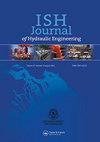Turbulence effect on total mechanical energy budget and energy loss of turbulent flows with different hydraulic regimes in open-channel transitions
引用次数: 0
Abstract
ABSTRACTIn this study, a modified form of the total mechanical energy budget equation is developed for 3-D turbulent flows with different hydraulic regimes in open-channel transitions, from which the effect of all turbulence parameters can be evaluated by applying some equalizations and RANS numerical simulations. The total energy equation is also used to extract an explicit relationship for energy loss based on turbulence parameters. The findings are presented in the form of the application of the relationship to calculate the energy loss based on simulation results for subcritical turbulent flow and hydraulic jump in open-channel transitions, which leads to identifying the effect of non-homogeneity and anisotropy of turbulence on flow energy balance. The results show that the work done by viscous shear stresses, the viscous diffusion of turbulence, and the turbulent diffusion have little to no effect on the total mechanical energy budget of open-channel turbulent flows; instead, the effect of the variations of turbulent kinetic energy and the work done by turbulence stresses is more significant. The benefit of using the modified energy equation is demonstrated by the potential for evaluating the details that were not previously considered.KEYWORDS: Mechanical energy lossenergy budgetturbulent flowdifferent hydraulic regimesnumerical simulations Disclosure statementNo potential conflict of interest was reported by the authors.Data availability statementAll data and models generated or used during the study appear in the submitted article.Notes1. second order, upwind-biased, unbounded.Additional informationFundingThis research received no specific grant from any funding agency in the public, commercial, or not-for-profit sectors. The authors have no relevant financial or non-financial interests to disclose.湍流对明渠过渡中不同水力状态湍流总机械能收支和能量损失的影响
摘要本文针对明渠过渡中不同水力状态的三维湍流,建立了一种修正的总机械能平衡方程,并通过一些均衡化和RANS数值模拟来评估各湍流参数的影响。利用总能量方程,导出了基于湍流参数的能量损失的显式关系。通过对亚临界湍流和明渠过渡段水力跃变的模拟结果,将该关系式应用于计算能量损失,从而识别出湍流的非均匀性和各向异性对流动能量平衡的影响。结果表明:粘性剪切应力所做的功、湍流的粘性扩散和湍流扩散对明渠湍流的总机械能收支影响很小或没有影响;相反,湍流动能的变化和湍流应力所做功的影响更为显著。使用修正后的能量方程的好处可以通过评估以前没有考虑到的细节的潜力来证明。关键词:机械能损失、能量预算、湍流、不同水力工况、数值模拟披露声明作者未报告潜在利益冲突。数据可用性声明在研究过程中生成或使用的所有数据和模型均出现在提交的文章中。二阶,逆风偏置,无界。本研究未获得任何公共、商业或非营利部门的资助机构的特别资助。作者没有相关的财务或非经济利益需要披露。
本文章由计算机程序翻译,如有差异,请以英文原文为准。
求助全文
约1分钟内获得全文
求助全文
来源期刊

ISH Journal of Hydraulic Engineering
Engineering-Civil and Structural Engineering
CiteScore
4.30
自引率
0.00%
发文量
59
 求助内容:
求助内容: 应助结果提醒方式:
应助结果提醒方式:


